TEAM EFFORT
A braai worth winning a world championship for
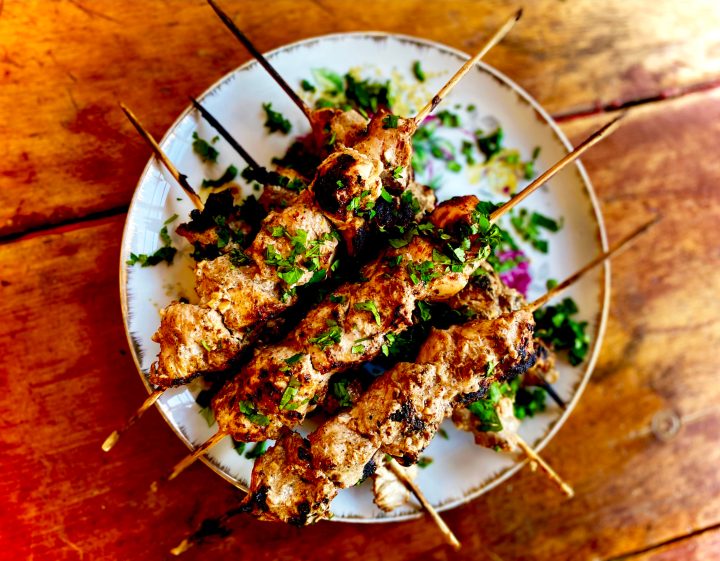
Gather family and friends for a braai with the TV blaring, beers cracked open, and a feast to splurge on while we all wait, riveted, for the outcome of one of the most anticipated Rugby World Cup finals in history.
We’re going to be on the edge of our seats anyway, so may as well have a plate groaning with lekker braaied food on our laps too. Braaing is one of the favourite pleasures of your Food Editor, and I’ve selected a range of recipes to help you plan your rugby-filled weekend.
And braaing is not only about meat. You also need side dishes, so we’ve got some vegetable and bread dishes too, alongside meat dishes from chicken and pork to lamb.
Here are 10 recipes to give you an appetite for a braai as well as the rugby…
Deboned leg of lamb in a spicy marinade
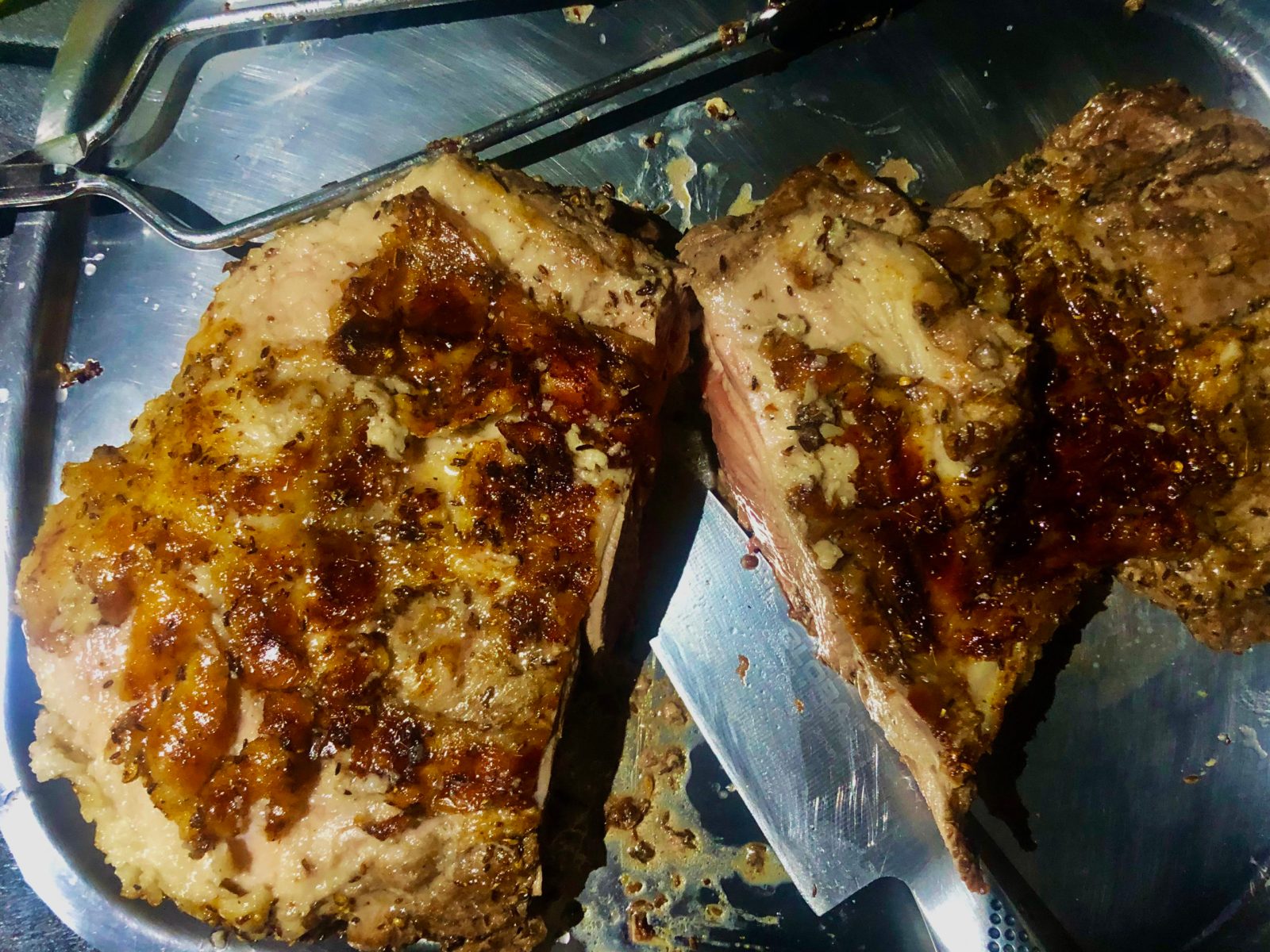
Tony Jackman’s deboned leg of lamb in a spicy marinade of toasted caraway, fennel, cumin and coriander seeds with lemon, garlic, chilli and olive oil. (Photo: Tony Jackman)
Caraway is a spice often overlooked, but it adds an indefinable something to a marinade for lamb, along with the more common marriage of cumin, fennel and coriander.
Try this for a 36-hour marinade for a leg of lamb, deboned all by yourself. Just follow the bone and be sure to keep the whole piece of lamb intact while you debone, and every time you do it you’ll be more practised at this kitchen art worth having in your arsenal. Along with the toasted seeds, which you crush with a mortar and pestle after toasting in a dry pan, are lemon juice, olive oil, fresh garlic and dried chilli flakes. All of that, plus time.
Ingredients
2 Tbsp cumin seeds
1 Tbsp caraway seeds
1 Tbsp coriander seeds
1 Tbsp fennel seeds
1 Tbsp dried chilli flakes
Juice of 2 lemons
⅓ cup olive oil
3 garlic cloves, crushed and chopped
Salt
Black pepper
Method
Toast the seeds in a dry pan, then crush them using a mortar and pestle, or grind them. Mix the spices with the remaining ingredients and douse the leg of lamb in it, rubbing it in all over.
Marinate in the fridge for 36 hours.
Braai over medium coals for 25 to 40 minutes, turning several times. Apply more marinade while cooking if there is any left over. The cooking time will depend on the thickness of the leg you have. Test for doneness by inserting a skewer. Pink juices for medium rare, if it runs red it’s underdone. Clear juices and oh dear…
Twice-cooked picanha steaks
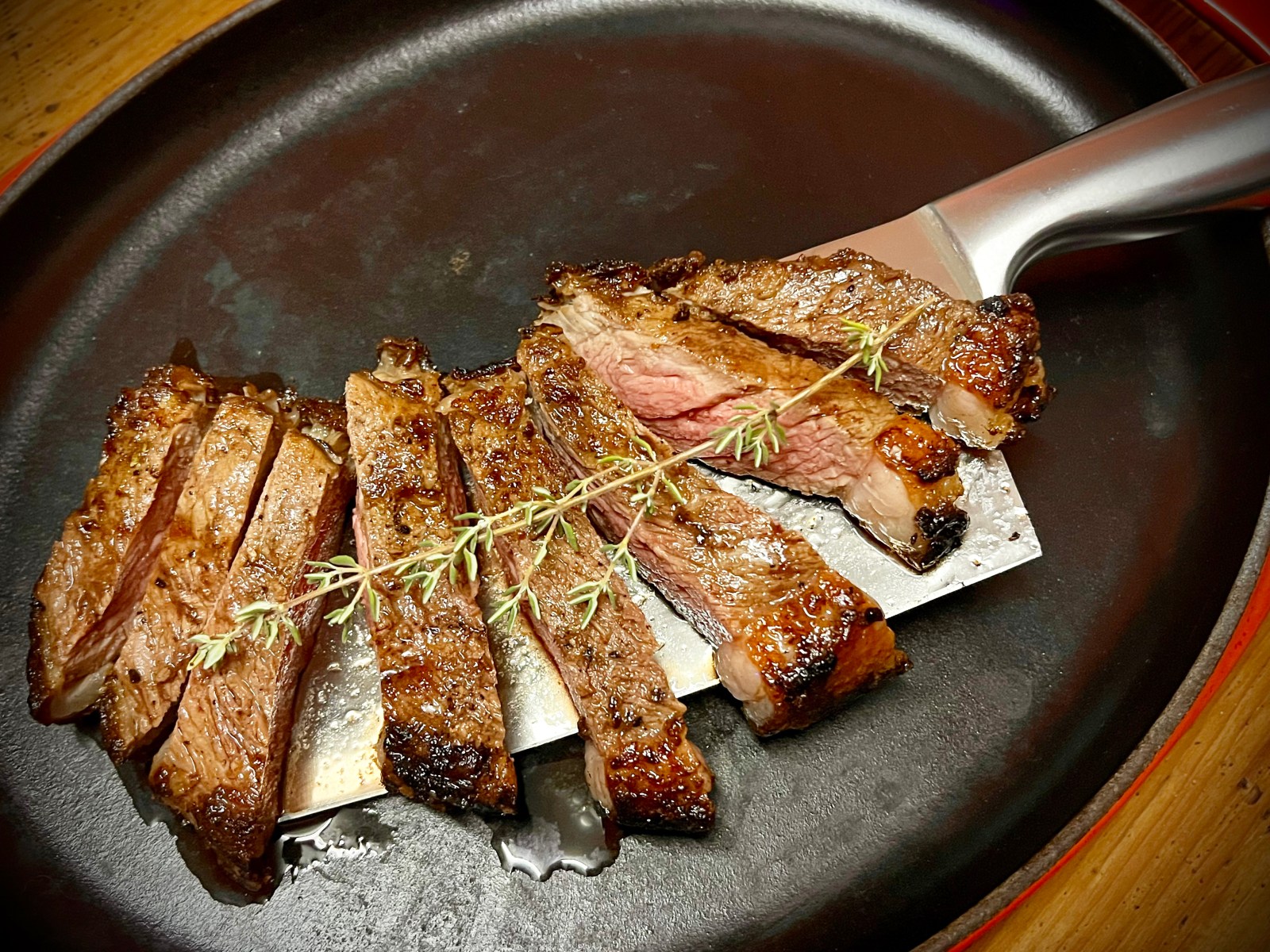
Tony Jackman’s picanha, twice-cooked on the braai, served on a cleaver. (Photo: Tony Jackman)
Since discovering picanha steak a few years ago, I’ve become a fanboy of this super cut and the Brazilian way of cooking it.
You know you’ve done something right when the dinner table is agog with oohs, aahs and other exclamations of intense pleasure to the point of blushing. With all the humility I can muster, I think this might have been the best steak I’ve ever cooked; yes, even better than that reverse-seared steak you all loved so much.
Seems I’m on a steak roll, so to speak. (This, from a cook with a life-long history of messing up steak, so I’m enjoying it immensely.) Best I write it down for you then…
Picanha is the tail end of the rump (which of course is the tail end of the beast), but a rump steak can have as many as five separate muscles, whereas picanha is just one. This makes for even cooking and tenderness.
A picanha is best cooked whole, first, then sliced into steaks and grilled again. For the first time, I marinated a picanha for as long as 36 hours. Hooboy, this was so good.
One key factor is that you must score the fat cap. And whatever you do, don’t trim the fat, because picanha is all about that fat cap. Cooked to perfection, the crisp fat is the most delicious part of the cut.
For extra citrus tang I included yuzu paste in the marinade, which gives it a bit of bite as well, as does the mustard. Yuzu is made from the zest of yuzu fruit mixed with chilli and sea salt.
Ingredients
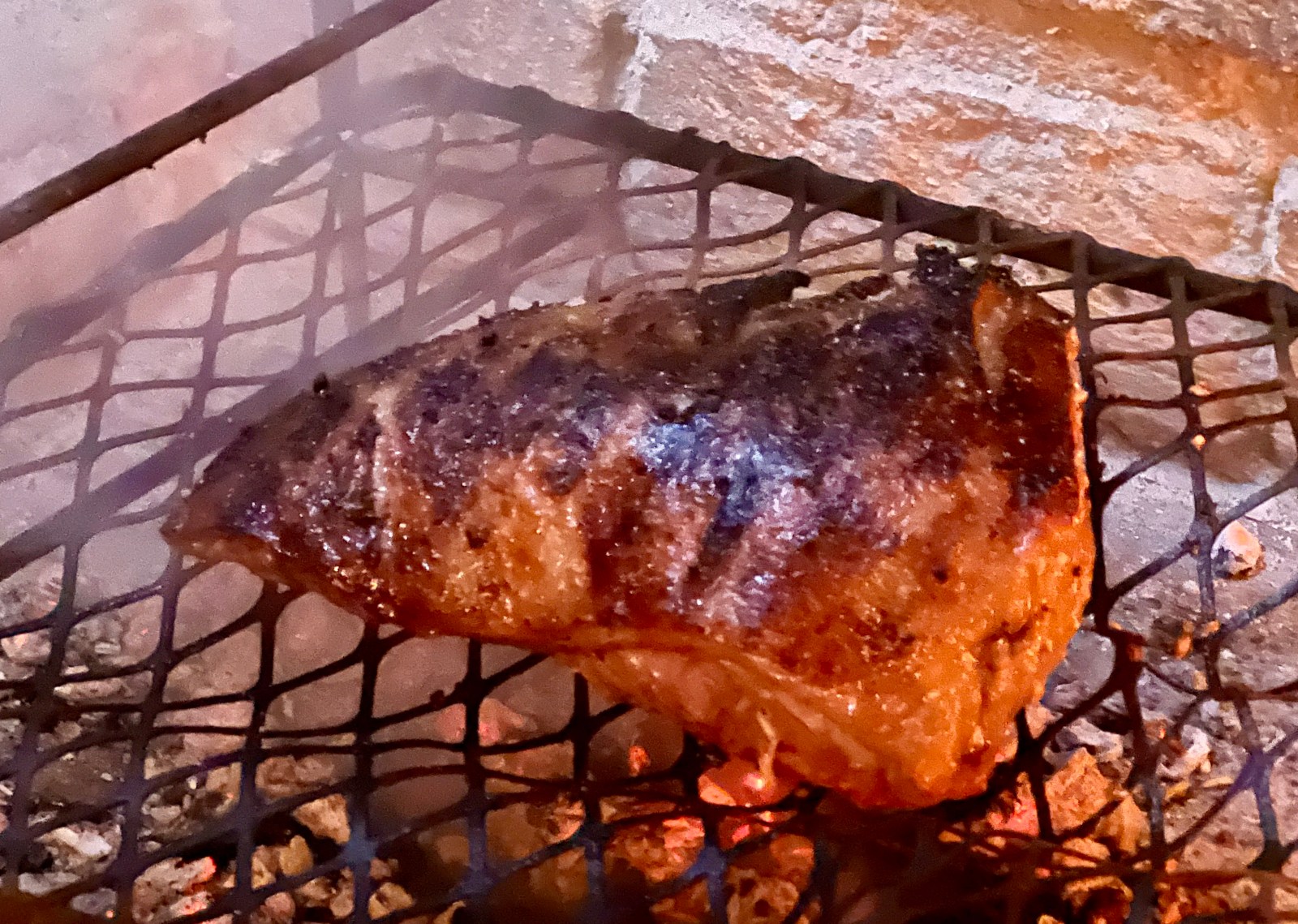
Picanha on the braai. (Photo: Tony Jackman)
8 fat garlic cloves, chopped
½ cup olive oil
Juice of 1 lemon
1 Tbsp yuzu paste
1 Tbsp mustard powder
2 Tbsp fresh oregano leaves
2 tsp black peppercorns
Method
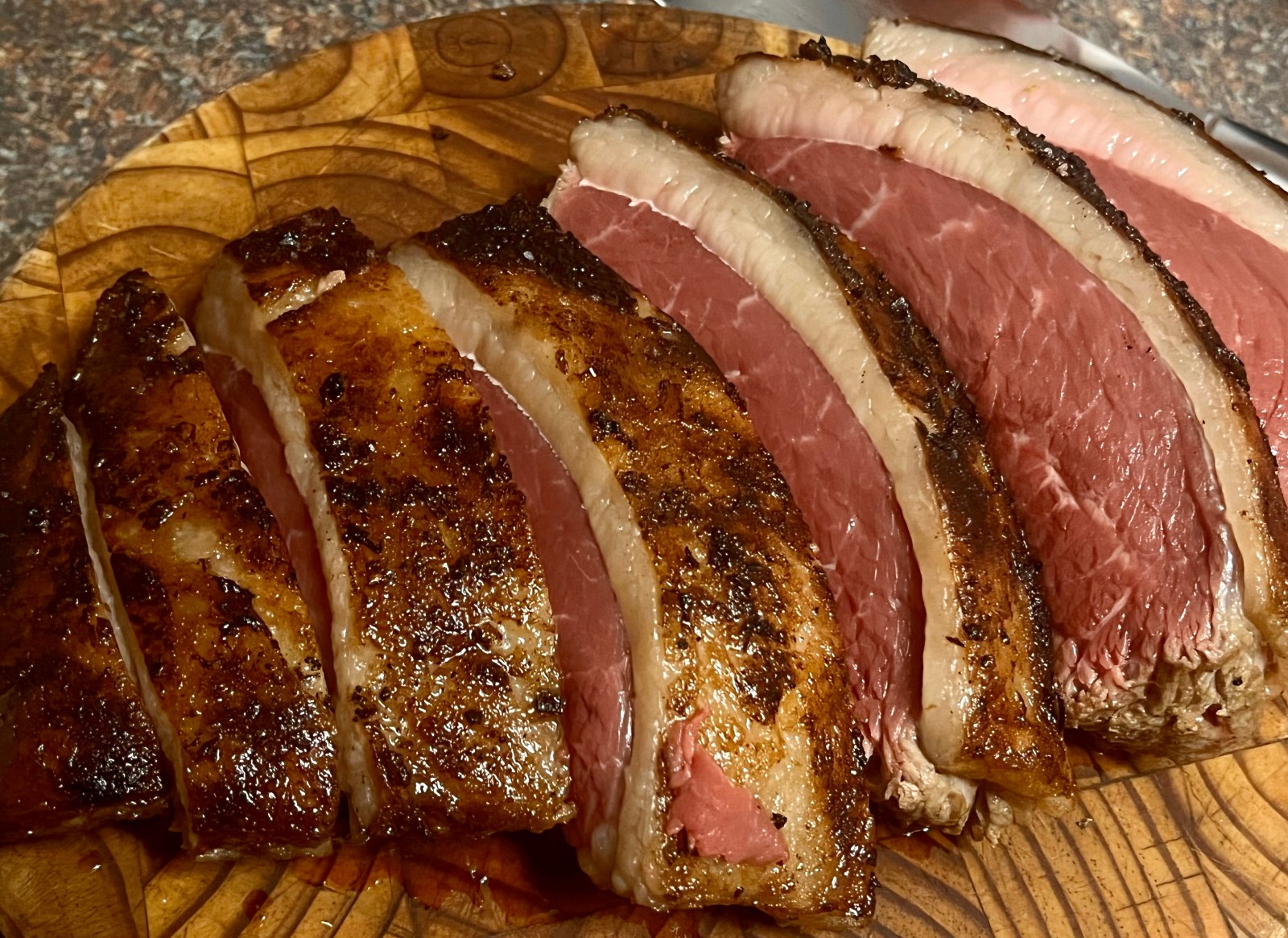
Picanha sliced and ready for the second grilling. (Photo: Tony Jackman)
Using a very sharp knife, score the fat in a diamond pattern without piercing any of the meat.
Mix together the olive oil and juice of a lemon and stir in the yuzu paste, mustard powder, garlic, oregano and black peppercorns. It’s an unusual mix and there’s a mighty amount of garlic in there, but trust me, it is truly delicious.
Marinate the picanha in this mixture for 24 hours or more, mine went for 36 hours-plus.
First, braai the whole picanha over very hot coals, turning frequently, until you have a beautiful crunchy and golden brown exterior.
Remove the whole picanha to a board and cut it into thick steaks: reference the photo.
Now put those steaks back on the braai and cook them quickly on both sides over a high heat. Ideally, leave them pink in the middle. About 2 minutes on each side ought to be enough, but that depends on the strength of the heat under it. More heat is best for this cut of meat.
Serve it up and sit back and be overwhelmed by what you’re eating, and the expressions and sounds of enraptured carnivores at the table. Bibs may be useful.
Deboned pork loin chops on the braai
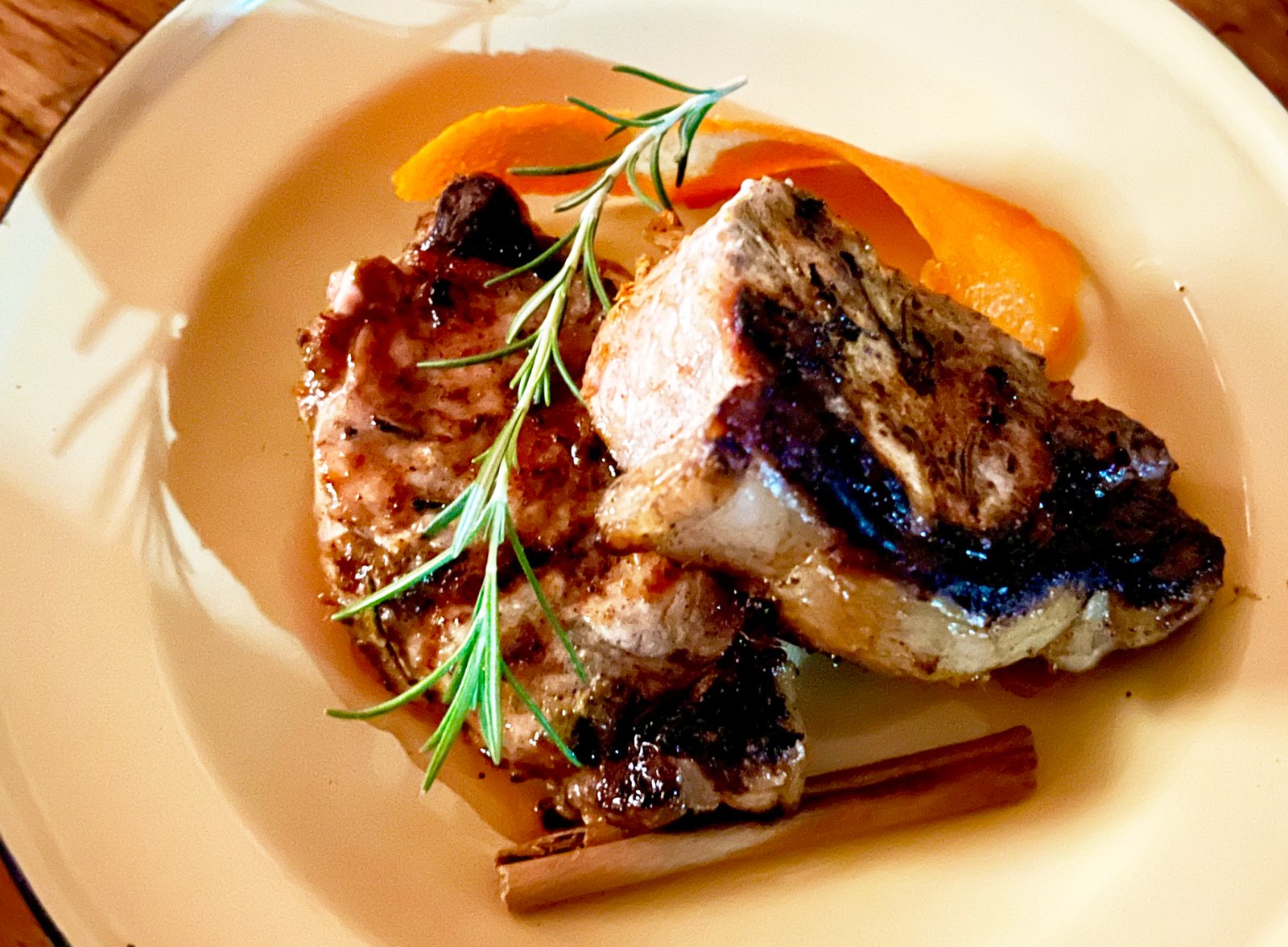
Tony Jackman’s deboned pork loin chops cooked on hot coals. (Photo: Tony Jackman)
Pork loin chops, cut thick and served with the bone cut away, have become a common sight in butcheries; or ask your butcher to cut and trim them for you.
Pork needs a careful touch and a slow cook high above the coals. Pork loin chops are pleasantly meaty, with a glorious cap of fat that can be allowed to crisp to golden satisfaction. Try giving them a harsh, super-hot singeing first, then raise the grid really high and let them cook towards the edge of the grill until tender and no longer pink at the centre.
These have a nice zesty flavour from orange, and some herby punch from rosemary, and a cinnamon hit for a sweetly spicy finish. Don’t be afraid of mixing herbs with spices; the combinations often add to a dish’s umami.
Ingredients
4 pork loin chops, deboned
Juice and zest of 1 orange
1 Tbsp olive oil
2 or 3 fresh rosemary sprigs
1 tsp ground cinnamon
Salt and black pepper to taste
Method
Mix together the juice, oil, zest, cinnamon, and the rosemary needles pulled off the sprigs. Douse the pork chops in this mixture and let it marinate in the fridge for a few hours. Remove an hour before cooking.
Have lots of hot coals ready. Season on both sides with salt and pepper. Grill the chops close to very hot coals for 2 or 3 minutes per side, and let them catch some flames if you have them.
Raise the grid high and place the chops near the edges of the grid. Let them cook until cooked through but tender, turning once or twice. Be careful not to leave them too long: push down in the centre with your finger; they should be soft but pliable, not hard at all.
Cumin & lime potjie-roasted chicken
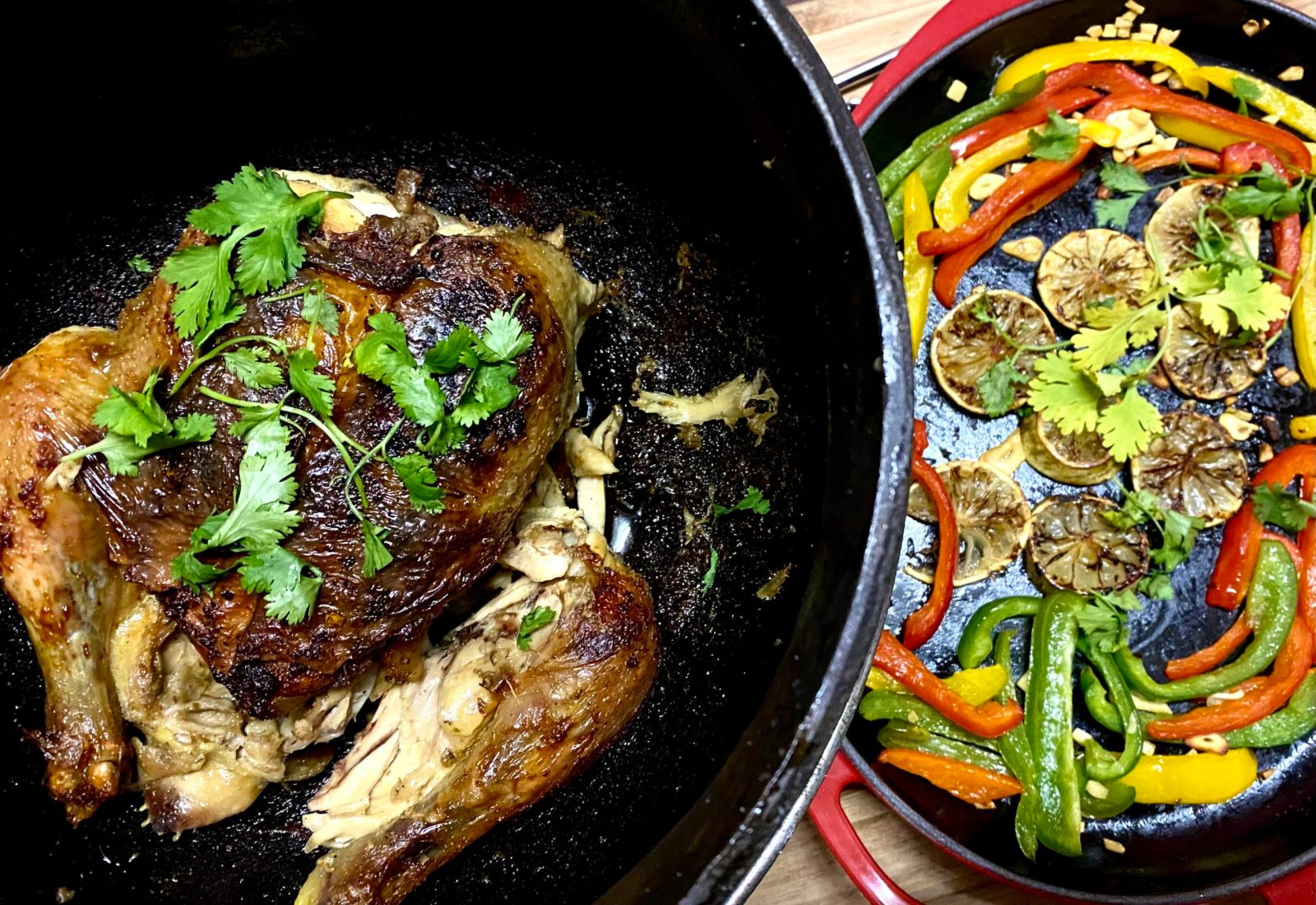
Chicken roasted in a potjie with lime, cumin, coriander and garlic. On the plancha are red, green and yellow peppers and plancha-grilled lime slices. (Photo: Tony Jackman)
Here’s a new take on my method of roasting a whole chicken in a potjie. Ring the changes with the dark bite of cumin and the zesty zing of limes, with fresh coriander, chilli and garlic to enliven it further.
Ingredients
1 whole chicken
4 Tbsp olive oil
1 heaped Tbsp chopped coriander stems
2 garlic cloves, chopped finely
1 Tbsp ground cumin
½ Tbsp ground coriander
1 jalapeño chilli, chopped finely
Grated zest of 2 limes
To serve:
½ each of a green, red and yellow pepper
Olive oil
Chopped garlic
2 limes, sliced
Method
In a small bowl, mix together the olive oil, coriander stems, garlic, ground cumin, ground coriander, chilli and lime zest. Mix to a paste.
Salt the cleaned bird well inside and out.
Lift the skin from the breasts at both ends and prise away with your fingers. Using a teaspoon, spoon in half of the mixture, spreading it around by massaging the skin above it. Smear the remaining mixture all over the outside of the bird, especially on the breast skin.
Heat oil in a potjie. When hot, put the chicken in, breast-side down, give the potjie a good shake, and cook it uncovered for about 15 minutes. Turn it using two smallish wooden spoons, carefully, to brown on the other side. Repeat this process until it is well browned all over. Then cover with the potjie lid and cook for about 90 minutes to two hours, keeping enough coals underneath (around the perimeter is best) and a few small coals on top to ensure regular cooking.
Serve with julienne red and yellow bell peppers stir-fried with slices of garlic, and slices of grilled lime. I used my plancha, which is a great piece of gear: a slender, flat grill pan which you can use on the stovetop or on the braai grid. Its winning factor is that it conducts heat all over evenly. Garnish both dishes with coriander leaves.
Sweet & sour pork sosaties
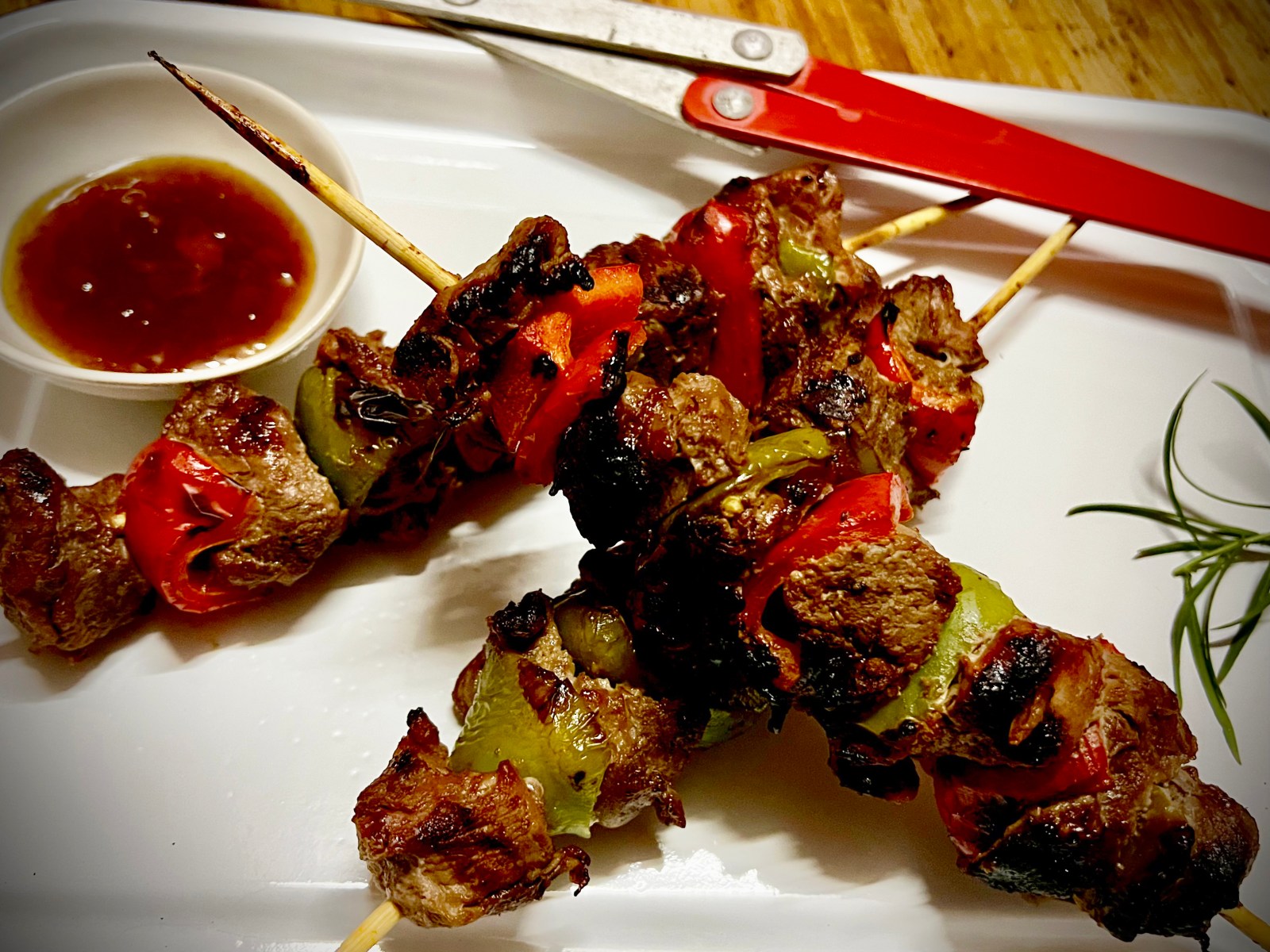
Tony Jackman’s sweet and sour pork sosaties. (Photo: Tony Jackman)
A balance of sweet and sour notes suits pork perfectly. This recipe melds an old South African braai tradition with the sweet and sour concept from Chinese cuisine.
South African pork sosaties with a sweet sauce that includes apricot jam and some spice is a great braai tradition. This recipe is a variation of that idea, including the use of bell peppers to intersperse with the chunks of lean pork.
Chinese (or Chinese-American) sweet and sour pork includes pineapple juice and tomato sauce, and there are neither of those in this. But I did include red wine vinegar and Mrs HS Ball’s chutney, with a hint of good old Worcestershire sauce for a bit of depth. There’s no cornflour in this either, which is essential for Chinese sweet and sour pork.
You can marinate it for a few hours or overnight if you like, or simply whip up the ingredients and use it as a baste.
Ingredients
Pork fillet sosaties
1 pork fillet, about 700-800 g, trimmed of sinew
1 green bell pepper
1 red bell pepper
3 Tbsp Mrs HS Ball’s chutney (any strength)
2 Tbsp red wine vinegar
2 tsp Worcestershire sauce
2 tsp Tabasco sriracha (less if you prefer less heat)
½ tsp garlic salt
Black pepper to taste
Salt to taste
4 wooden or metal skewers
Method
Carefully remove any sinew from the exterior of the pork fillet. Cut it into cubes and put them in a bowl. Salt lightly and toss.
In a small bowl, mix together the chutney, vinegar, Worcestershire sauce, sriracha sauce, garlic salt and black pepper.
Add this to the meat and mix well with a wooden spoon so that the meat is well coated all over. Cover and marinate in a fridge, if not using immediately.
If using wooden skewers, soak them for half an hour in cold water so they do not blacken on the fire.
Remove the seeds from the bell peppers and slice into pieces.
Skewer the cubes of pork, interspersed with the peppers.
Keep any remaining sauce to use as a baste on the fire.
Prepare plenty of hot coals, then spread them out and place the grid fairly high above them, so that the meat does not cook too quickly. Slowish cooking will help you achieve tender, soft meat. Pork toughens easily, even the fillet, so be careful not to overcook them.
Tandoori chicken sosaties
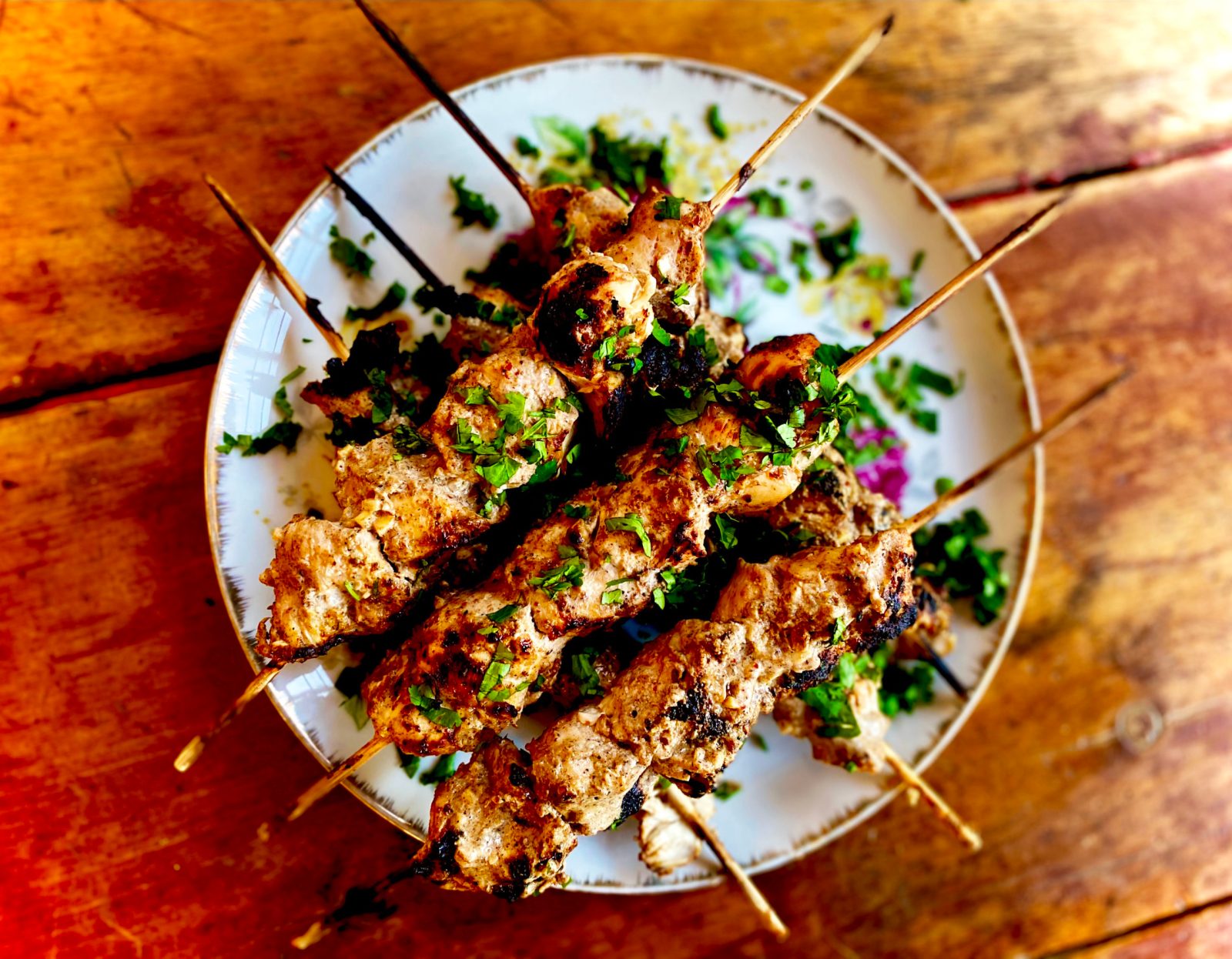
Tandoori-spiced chicken sosaties. (Photo: Tony Jackman)
The tandoori spice mix we made last weekend has been put to good use. It was used to make both the broccoli skewers recipe we published this week, and these very moreish chicken kebabs.
Of course you can cook these in a tandoor if you’re lucky enough to own one. I cooked them quickly over very hot coals, really close, to emulate the fiery heat of a tandoor.
Ingredients
4 chicken breast fillets, cubed (not too tiny or they will dry out while cooking)
3 Tbsp tandoori spice mix
3 garlic cloves, chopped finely
4 cm piece of ginger, peeled and finely grated
5 Tbsp thick plain yoghurt
Method
Mix marinade ingredients and dice chicken. Massage chicken cubes in the marinade and leave to marinate for two or three hours.
Skewer and braai them close to very hot coals. They should only take a few minutes, turning. They need to char a little on the outside yet still be succulent within.
Butternut with prosciutto and feta
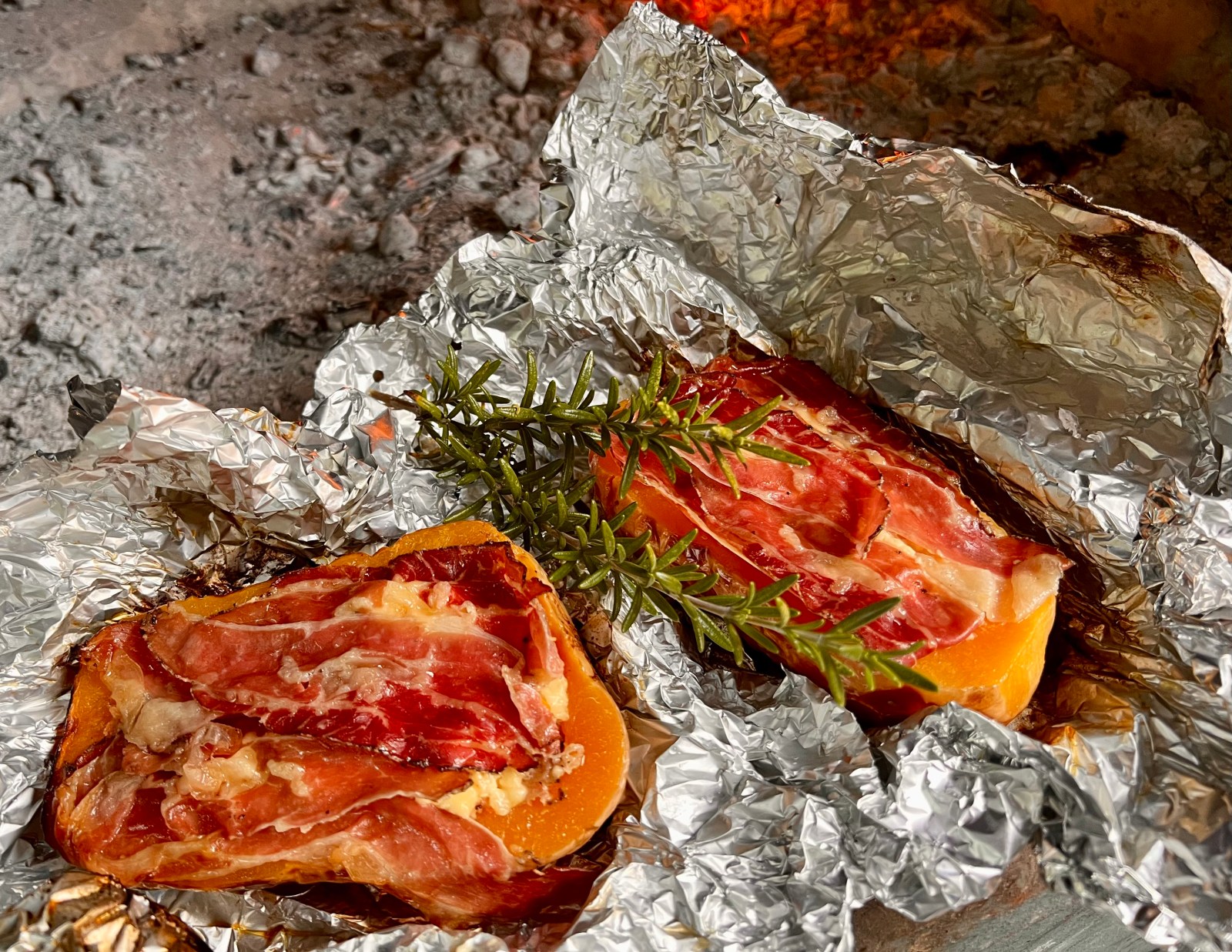
Tony Jackman’s butternut with feta and prosciutto, braaied in foil in the coals. (Photo: Tony Jackman)
Baking halved butternuts in foil after filling them with quality feta and covering them in fancy prosciutto takes a braaied vegetable up a notch.
It was astonishing how much of the flavour of the prosciutto imbued the flesh of butternut halves while they were cooking in the coals, wrapped snugly in their shiny foil sleeping bags. There was really good full-cream Jersey feta in them too, which melted beautifully. Cook as many or as few butternuts as you like, to feed a crowd or just yourselves.
Ingredients
(For 1 butternut; multiply as needed)
1 butternut, halved, seeds removed
1 round of Dalewood Fromage full cream feta from a pasture-fed Jersey herd (or other quality feta)
80 g Richard Bosman prosciutto (or other quality brand)
Salt and black pepper to taste
Olive oil
Method
Retain 4 to 6 rashers of prosciutto and chop the remainder into small pieces.
Crumble feta and mix it with the chopped prosciutto, seasoning it lightly with black pepper.
Halve the butternut/s and scoop out the seeds. Season the cavities and the flat area with salt and pepper and drizzle with olive oil.
Share the feta-prosciutto mixture equally between the two halves, pushing it hard into the cavities. Pile the remaining crumbled mixture along the flat surface of the butternut, squashing it with your palm to make it stick.
Drizzle olive oil over (so that it does not stick to the foil) and wrap tightly in double-folded heavy foil.
Braai in hot coals until tender but not so long that they dry out. About 25 to 30 minutes. Pierce with a skewer to test whether they are soft all the way through.
Hasselback potatoes in the coals
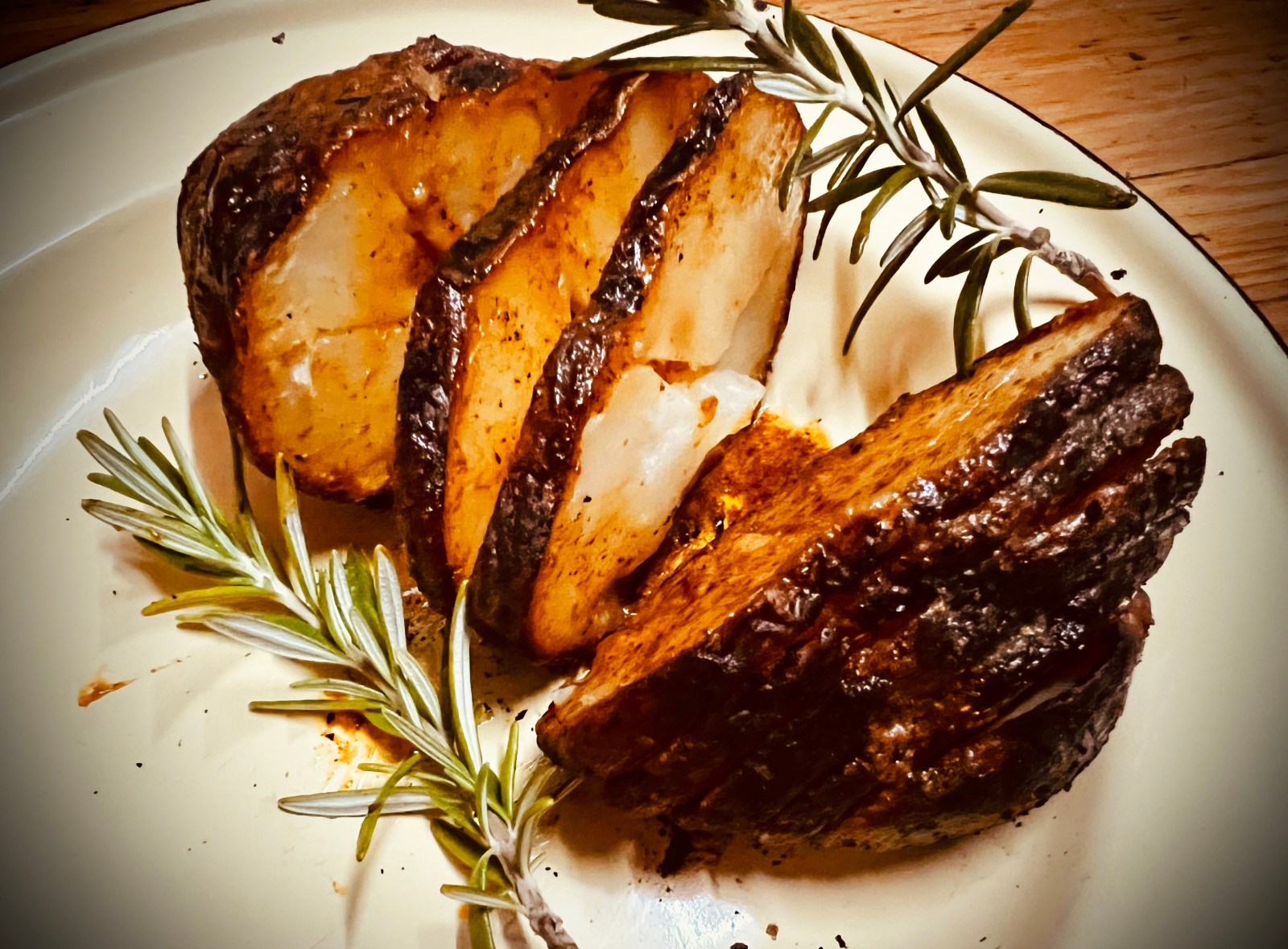
Tony Jackman’s paprika-butter hasselback potato cooked in foil in hot coals, served on an enamel plate. (Photo: Tony Jackman)
Can you cook hasselback potatoes in the coals? Would they have that roast-potato crispiness that makes them so great? I needed to know.
Hasselback potatoes are ridged and cooked in very hot oil in the oven. They turn out beautifully crisp. They’re a dream to all of us who love the crunch that only a perfectly cooked chip or roast potato can give, and hasselbacks give more crunch than most.
Normally, the oil has to be preheated in a pan (I use a deep loaf tin) in a very hot oven so that when you slide them potatoes into the oil (using a slotted spoon) the fat starts splattering instantly. Then they cook for at least an hour, perhaps 90 minutes, until they’re just divine.
But coals are not an oven, and there’s nowhere for the oil to go. Could it work as well? Yes, it could.
These came out very well, brimful of flavour from the paprika butter I used, the outer shells super crisp. Unlike oven hasselbacks, the crispiness did not continue into the slits of the sliced upper parts, but the outer ridges had a beautiful crunch.
But they do need time, a double wrapping of heavy-duty foil, and need to be cooked right in the very hot coals.
Here’s how…
Ingredients
For 4 hasselback potatoes:
4 medium to large potatoes
4 double-folded pieces of foil (be generous)
4 Tbsp butter, at room temperature
1 heaped tsp paprika
Salt and black pepper to taste
Method
Prepare a fire with masses of hot coals.
Peel the potatoes. Using a sharp knife, very carefully slice them until just over halfway through using a sawing motion. Make the gaps between them very narrow so that 1 cm has about three slits in it. Mind your fingers.
In a bowl, mix together the butter, paprika, salt and pepper.
Using fingers to prise each slit apart just a little, use a blunt knife to push butter into each slit, as much as you can without breaking them. Spread the rest of the paprika butter over the outside of the potatoes.
Wrap each potato in double foil, tightly.
Braai them right in the coals, adding more coals as necessary. Mine took about an hour, turning every 10 minutes or so.
Go on, make a double batch. They’re very moreish.
Braai pot potato and peppers bake
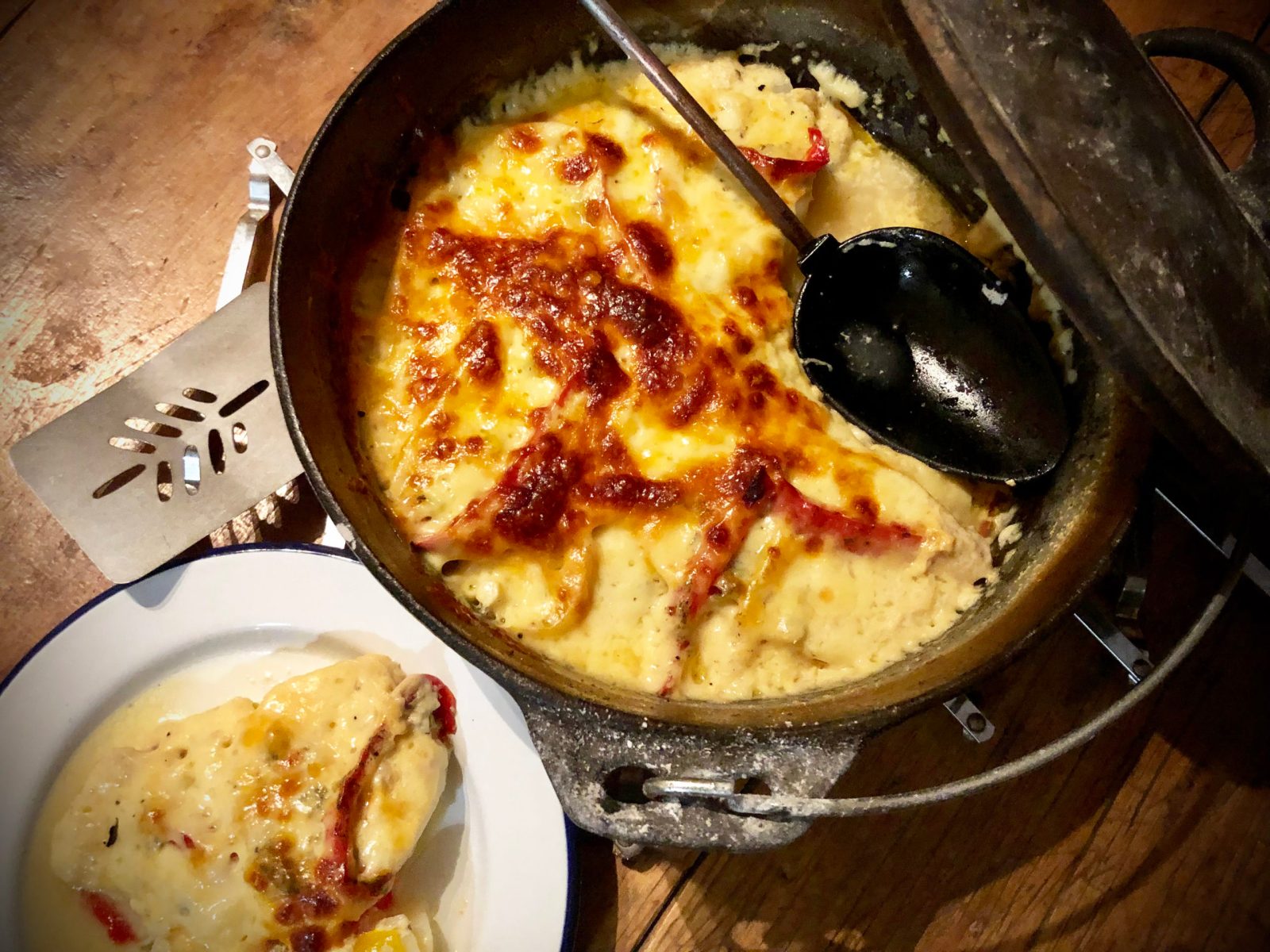
Tony Jackman’s braai and bell peppers potato bake. (Photo: Tony Jackman)
A round cast-iron braai pot is good for more than just braai bread. Try it for a potato bake, in this case with red and yellow bell peppers and a touch of chilli.
Potato bakes happen in ovens, right? They’re made of cream and stock and herbs and/ or spices, plenty of butter, and potatoes that have been scalloped, that is, sliced thinly, then layered, often with onions.
It’s one of those things that almost everyone loves, like bacon, and you can put that in it too if you like. But does a potato bake have to be cooked in the oven? I decided to do exactly what you’d do with a potato bake in an oven dish, but in a braai pot instead. To compensate for the oven you need to have coals around the base for the duration of its cooking, as well as coals on the top.
I topped mine with grated cheese as well. Once that’s been piled on top well into the cook, you need to put the lid back on with lots of coals on top to help get that lovely crisp, golden and crunchy cheesy topping.
Ingredients
2 Tbsp olive oil
4 to 6 large potatoes
1 red pepper, sliced
1 yellow pepper, sliced
3 spring onions, chopped
5 garlic chives, chopped
1 red chilli, chopped
1 green chilli, chopped
Butter
400 ml cream
400 ml vegetable stock
Salt to taste
Black pepper to taste
1 cup grated mozzarella
1 Tbsp cornflour
2 Tbsp milk
Method
Light a fire so you have a supply of hot coals. Clean and dry the braai pot. Oil the pot on the bottom and sides.
Peel the potatoes and slice thinly.
Slice the peppers into julienne strips, chop the spring onions and chives and chillies.
Arrange a layer of potato slices at the bottom and season with salt and pepper. Dot each slice with a knob of butter. Add a few slices of peppers of both colours and sprinkle with salt and pepper. Repeat the layers as well as the dotting with butter and seasoning until everything is used up, ending with a layer of peppers, spring onion and chives.
Mix the cream and stock in a jug and pour over.
Put the lid on and place hot coals all around the base and more on the lid.
Cook until the potatoes are tender, about 90 to 100 minutes. Forty-five minutes in, stir in 1 Tbsp cornflour mixed with 2 Tbsp milk, cover again and continue cooking with more coals on the lid.
An hour in, sprinkle the grated mozzarella on top, cover again, add masses of coals to the lid and keep cooking until the cheese has melted and turned golden.
Olive braai bread
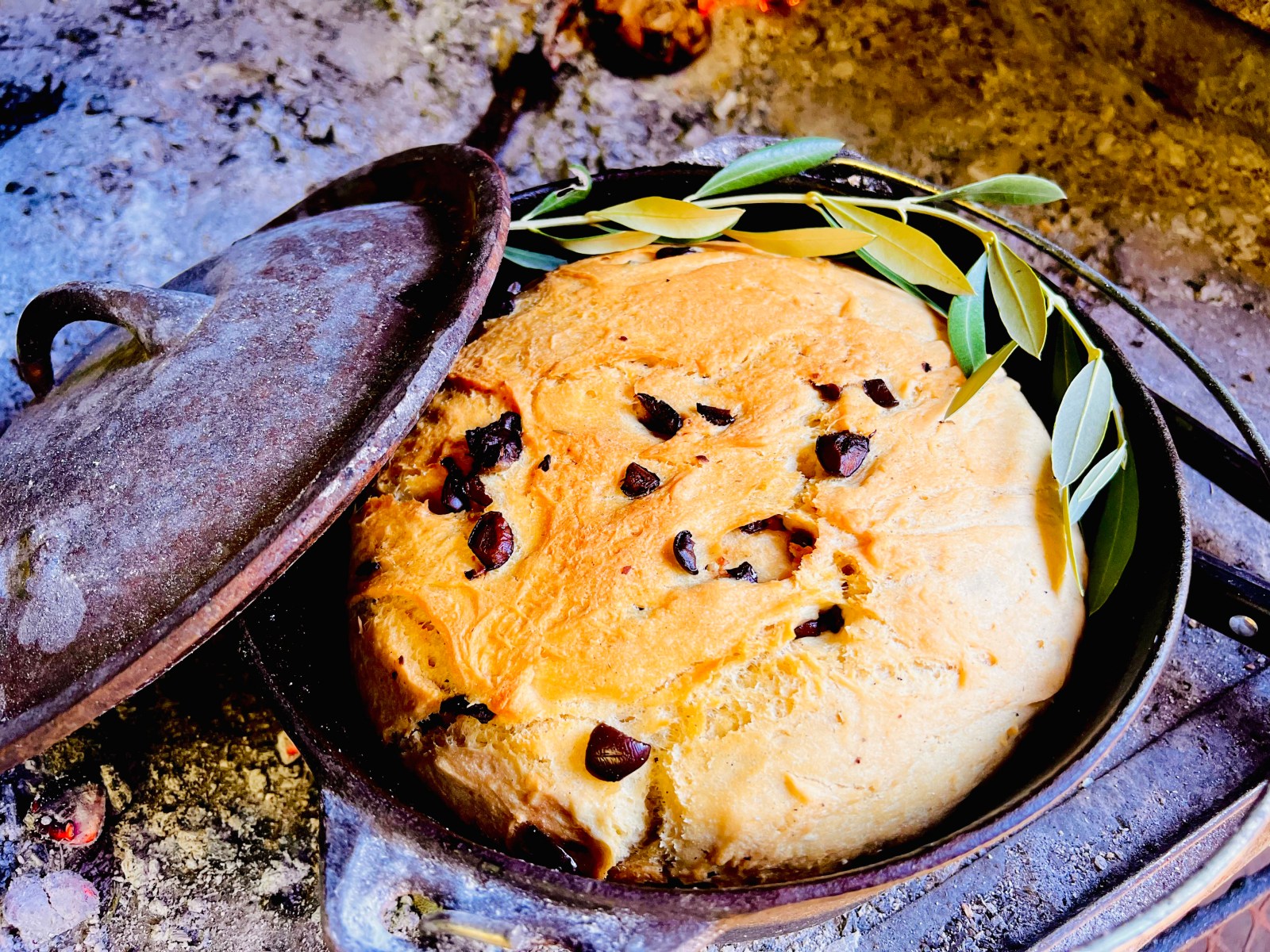
Tony Jackman’s olive pot bread. (Photo: Tony Jackman)
Here’s another take on a basic pot bread (potbrood), but given a Mediterranean twist with lovely plump black olives.
Take advantage of these height-of-summer days with this lazy pot bread that needs only a 20-minute rise (though I give it half an hour and there’s no reason why not) before being eased into an oiled flat-bottomed pot and cooked with the aid of a few hot coals for just an hour.
Ingredients
1 kg white bread wheat flour
10 g instant yeast
4 tsp sugar
1 tsp salt
2 cups lukewarm water and a little more if necessary
2 Tbsp olive oil
½ a cup black olives, chopped
Olive oil for the pot
Method
Sift the flour into a large mixing bowl. Add the yeast and sugar and stir well with a wooden spoon. Only stir in the salt after this so that it does not neutralise the yeast.
Add lukewarm water a little at a time, while kneading the dough, until it is all combined. Now add the 2 Tbsp olive oil and continue kneading until it is a nice plump ball of dough and no longer sticky. Add the olives (depip and chop them into little pieces first) to the dough in the bowl and knead again for a few minutes, turning and push-pulling with your hands/fists, until all the bits of olive are evenly distributed.
Leave the ball of dough in the bowl, cover with a slightly damp tea towel, and put it in a warm spot outside for 20 minutes, or inside if the weather is not playing ball. The Foodie’s Wife, who has occasional flashes of kitchen genius, taught me the trick of turning on the oven till it is a little warm, then turning it off and putting the dough in there to rise.
Check that you have braai coals. Oil the inside of your heavy-bottomed pot well. Carefully ease the dough into it; you may need to use a silicone spatula to scrape the edges downwards. Put the lid on the braai pot. Place in the braai and immediately place hot coals all around the base, and a few more on top. Keep replenishing the coals at the base and on the lid for a full hour. Remove the lid, and it should turn out perfectly. Like the one in the picture. DM
Tony Jackman is Galliova Food Writer 2023, jointly with TGIFood columnist Anna Trapido.
Follow Tony Jackman on Instagram @tony_jackman_cooks.




 Become an Insider
Become an Insider
Comments - Please login in order to comment.